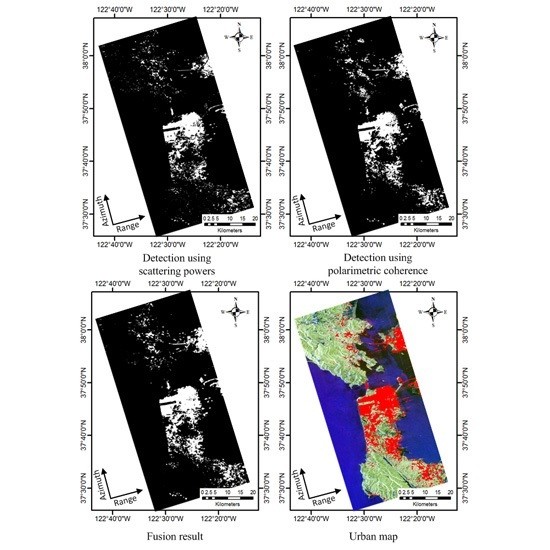Built-up Area Extraction from PolSAR Imagery with Model-Based Decomposition and Polarimetric Coherence
Abstract
:1. Introduction
2. Methodology
2.1. Multiple-Component Decomposition with Cross Scattering Model
2.2. Sub-Aperture Decomposition
- Fourier transformation in azimuth direction.2D Fourier transform is utilized to transform a PolSAR image into the spectral domain.
- Frequency spectrum segmentation using a window function.The total frequency spectrum is divided into several regions centered on the specific spectral locations using a window function such as Hamming window.
- Each part of the spectrum is transformed back into the spatial domain using 2D inverse Fourier transform.Using a 2D inverse Fourier transform, every sub-spectrum is transformed back into the spatial domain, and thus we can get a sub-aperture image representing the focused PolSAR response around a specific spectral location.
2.3. Polarimetric Coherence Coefficient Ratio Based on Sub-Aperture Images
2.4. Built-up Area Extraction Method
- (1)
- Sub-aperture decomposition on the SLC PolSAR data to obtain sub-aperture images.
- (2)
- Multilooking and despecking on the original SLC PolSAR data and sub-aperture images to estimate accurate sample coherency matrix.
- (3)
- Polarimetric target decomposition on original PolSAR data using our method to get the double-bounce scattering power and cross scattering power. Coherence coefficient ratio calculation using the sub-aperture images.
- (4)
- Built-up area detection using Condition 1 and Condition 2. Fusion of two detection results using the FCP algorithm.
3. Experimental Data Description
4. Results and Discussions
4.1. Analysis of the Decomposed Scattering Powers on Built-up Area Detection
4.2. Analysis of the Average Coherence Coefficient Ratio on Built-up Area Detection
4.3. Comparison of the Detection Results with and without Fusion
4.4. Discussion on the Detection Thresholds
5. Conclusions
Acknowledgments
Author Contributions
Conflicts of Interest
References
- Zhai, W.; Shen, H.; Huang, C.; Pei, W. Building earthquake damage information extraction from a single post-earthquake PolSAR image. Remote Sens. 2016, 8. [Google Scholar] [CrossRef]
- Zhao, L.; Yang, J.; Li, P.; Zhang, L.; Shi, L.; Lang, F. Damage assessment in urban areas using post-earthquake airborne POLSAR imagery. Int. J. Remote Sens. 2013, 34, 8952–8966. [Google Scholar] [CrossRef]
- Kajimoto, M.; Susaki, J. Urban-area extraction from polarimetric SAR images using polarization orientation angle. IEEE Geosci. Remote Sens. Lett. 2013, 10, 337–341. [Google Scholar] [CrossRef] [Green Version]
- Yamaguchi, Y. Disaster monitoring by fully polarimetric SAR data acquired with ALOS-PALSAR. Proc. IEEE 2012, 100, 2851–2860. [Google Scholar] [CrossRef]
- Li, X.; Guo, H.; Zhang, L.; Chen, X.; Liang, L. A new approach to collapsed building extraction using Radarsat-2 polarimetric SAR imagery. IEEE Geosci. Remote Sens. Lett. 2012, 9, 677–681. [Google Scholar]
- Wang, Y.; Tupin, F.; Han, C. Building detection from high-resolution PolSAR data at the rectangle level by combining region and edge information. Pattern Recognit. Lett. 2010, 31, 1077–1088. [Google Scholar] [CrossRef]
- Soergel, U. Radar Remote Sensing of Urban Areas; Springer: Berlin, Germany, 2010; Volume 15, p. 277. [Google Scholar]
- Guo, H.; Li, X.; Zhang, L. Study of detecting method with advanced airborne and spaceborne synthetic aperture radar data for collapsed urban buildings from the Wenchuan earthquake. J. Appl. Remote Sens. 2009, 3. [Google Scholar] [CrossRef]
- Zhai, W.; Shen, H.; Huang, C.; Pei, W. Fusion of polarimetric and texture information for urban building extraction from fully polarimetric SAR imagery. Remote Sens. Lett. 2016, 7, 31–40. [Google Scholar] [CrossRef]
- Chen, S.; Sato, M. Tsunami damage investigation of built-up areas using multitemporal spaceborne full polarimetric SAR images. IEEE Trans. Geosci. Remote Sens. 2013, 51, 1985–1997. [Google Scholar] [CrossRef]
- Huynen, J.R. Phenomenological Theory of Radar Targets. Ph.D. Thesis, Delft University of Technology, Delft, The Netherlands, 1970. [Google Scholar]
- Cloude, S.R.; Pottier, E. A review of target decomposition theorems in radar polarimetry. IEEE Trans. Geosci. Remote Sens. 1996, 34, 498–518. [Google Scholar] [CrossRef]
- Holm, W.A.; Barnes, R.M. On radar polarization mixed target state decomposition techniques. In Proceedings of the 1988 IEEE National Radar Conference, Ann Arbor, MI, USA, 20–21 April 1988; pp. 249–254.
- Van Zyl, J.J. Application of cloude’s target decomposition theorem to polarimetric imaging radar data. Proc. SPIE Radar Polarim. 1993, 1748. [Google Scholar] [CrossRef]
- Yamaguchi, Y.; Yajima, Y.; Yamada, H. A four-component decomposition of PolSAR images based on the coherency matrix. IEEE Geosci. Remote Sens. Lett. 2005, 3, 292–296. [Google Scholar] [CrossRef]
- Yamaguchi, Y.; Moriyama, T.; Ishido, M.; Yamada, H. Four-component scattering model for polarimetric SAR image decomposition. IEEE Trans. Geosci. Remote Sens. 2005, 43, 1699–1706. [Google Scholar] [CrossRef]
- Freeman, A.; Durden, S.L. A three-component scattering model for polarimetric SAR data. IEEE Trans. Geosci. Remote Sens. 1998, 36, 963–973. [Google Scholar] [CrossRef]
- Pellizzeri, T.M. Classification of polarimetric SAR images of suburban areas using joint annealed segmentation and “H/A/α” polarimetric decomposition. ISPRS J. Photogramm. Remote Sens. 2003, 58, 55–70. [Google Scholar] [CrossRef]
- Deng, L.; Yan, Y.-N.; Sun, C. Use of sub-aperture decomposition for supervised PolSAR classification in urban area. Remote Sens. 2015, 7, 1380–1396. [Google Scholar] [CrossRef]
- Deng, L.; Wang, C. Improved building extraction with integrated decomposition of time-frequency and entropy-alpha using polarimetric SAR data. IEEE J. Sel. Top. Appl. Earth Obs. 2014, 7, 4058–4068. [Google Scholar] [CrossRef]
- Ainsworth, T.L.; Schuler, D.L.; Lee, J.S. Polarimetric SAR characterization of man-made structures in urban areas using normalized circular-pol correlation coefficients. Remote Sens. Environ. 2008, 112, 2876–2885. [Google Scholar] [CrossRef]
- Lee, K.-Y.; Oh, Y.; Kim, Y. Phase-difference of urban area in polarimetric SAR images. Electron. Lett. 2012, 48, 1367–1368. [Google Scholar] [CrossRef]
- Ferro-Famil, L.; Lavalle, M. In detection and analysis of urban areas using ALOS PALSAR polarimetric data. In Proceedings of the 2009 IEEE International Geoscience and Remote Sensing Symposium, Cape Town, South Africa, 12–17 July 2009; pp. V-142–V-145.
- Reigber, A.; Jager, M.; He, W.; Ferro-Famil, L.; Hellwish, O. Detection and classification of urban structures based on high-resolution SAR. In Proceedings of the Urban Remote Sensing Joint Event 2007 (JURSE’07), Paris, France, 11–13 April 2007; Volume 1, pp. 1–6.
- Azmedroub, B.; Ouarzeddine, M.; Souissi, B. Extraction of urban areas from polarimetric SAR imagery. IEEE J. Sel. Top. Appl. Earth Obs. 2016, 9, 2583–2591. [Google Scholar] [CrossRef]
- Zou, B.; Lu, D.; Wu, Z.; Qiao, Z. Urban-area extraction from polarimetric SAR image using combination of target decomposition and orientation angle. Proc. SPIE Radar Sens. Technol. 2016, 9829. [Google Scholar] [CrossRef]
- Chen, S.-W.; Ohki, M.; Shimada, M.; Sato, M. Deorientation effect investigation for model-based decomposition over oriented built-up areas. IEEE Geosci. Remote Sens. Lett. 2013, 10, 273–277. [Google Scholar] [CrossRef]
- Zou, B.; Lu, D.; Zhang, L.; Moon, W.M. Eigen-decomposition-based four-component decomposition for PolSAR data. IEEE J. Sel. Top. Appl. Earth Obs. 2016, 9, 1286–1296. [Google Scholar] [CrossRef]
- Zou, B.; Zhang, Y.; Cao, N.; Minh, N.P. A four-component decomposition model for PolSAR data using asymmetric scattering component. IEEE J. Sel. Top. Appl. Earth Obs. 2015, 8, 1051–1061. [Google Scholar] [CrossRef]
- Xiang, D.; Ban, Y.; Su, Y. Model-based decomposition with cross scattering for polarimetric SAR urban areas. IEEE Geosci. Remote Sens. Lett. 2015, 12, 2496–2500. [Google Scholar] [CrossRef]
- Kusano, S.; Takahashi, K.; Sato, M. A new decomposition of a PolSAR coherency matrix using a generalized scattering model. IEEE J. Sel. Top. Appl. Earth Observ. 2015, 8, 3933–3940. [Google Scholar] [CrossRef]
- Zhang, L.; Zou, B.; Cai, H.; Zhang, Y. Multiple-component scattering model for polarimetric SAR image decomposition. IEEE Geosci. Remote Sens. Lett. 2008, 5, 603–607. [Google Scholar] [CrossRef]
- Xiang, D.; Tang, T.; Ban, Y.; Su, Y.; Kuang, G. Unsupervised polarimetric SAR urban area classification based on model-based decomposition with cross scattering. ISPRS J. Photogramm. Remote Sens. 2016, 116, 86–100. [Google Scholar] [CrossRef]
- Lee, J.-S.; Pottier, E. Polarimetric Radar Imaging: From Basics to Applications; CRC Press: Boca Raton, FL, USA, 2009. [Google Scholar]
- Xiao, S.; Chen, S.; Chang, Y.; Li, Y. Polarimetric coherence optimization and its application for manmade target extraction in PolSAR data. IEICE Trans. Electron. 2014, 97, 566–574. [Google Scholar] [CrossRef]
- Ferro-Famil, L.; Reigber, A.; Pottier, E.; Boerner, W.M. Scene characterization using subaperture polarimetric SAR data. IEEE Trans. Geosci. Remote Sens. 2003, 41, 2264–2276. [Google Scholar] [CrossRef]
- Spigai, M.; Tison, C.; Souyris, J.-C. Time-frequency analysis in high-resolution SAR imagery. IEEE Trans. Geosci. Remote Sens. 2011, 49, 2699–2711. [Google Scholar] [CrossRef]
- Zhang, J.; Xu, J.; Peng, Y.; Wang, X. Speckle filtering of SAR images based on sub-aperture technique and principal component analysis. In Proceedings of the IEEE International Symposium on Communications and Information Technology, Beijing, China, 12–14 October 2005; pp. 1217–1222.
- Ainsworth, T.; Jansen, R.; Lee, J.; Fiedler, R. Sub-aperture analysis of high-resolution polarimetric SAR data. In Proceedings of the IEEE International Geoscience and Remote Sensing Symposium, Hamburg, Germany, 28 June–2 July 1999; pp. 41–43.
- Hu, C.; Ferro-Famil, L.; Kuang, G. Ship discrimination using polarimetric SAR data and coherent time-frequency analysis. Remote Sens. 2013, 5, 6899–6920. [Google Scholar] [CrossRef] [Green Version]
- Wu, W.; Guo, H.; Li, X. Urban area man-made target detection for PolSAR data based on a nonzero-mean statistical model. IEEE Geosci. Remote Sens. Lett. 2014, 11, 1782–1786. [Google Scholar] [CrossRef]
- Wu, W.; Guo, H.; Li, X. Man-made target detection in urban areas based on a new azimuth stationarity extraction method. IEEE J. Sel. Top. Appl. Earth Obs. 2013, 6, 1138–1146. [Google Scholar] [CrossRef]
- Wu, W.; Guo, H.; Li, X. Urban area SAR image man-made target extraction based on the product model and the time—Frequency analysis. IEEE J. Sel. Top. Appl. Earth Obs. 2015, 8, 943–952. [Google Scholar] [CrossRef]
- Xiang, D.; Tang, T.; Ban, Y.; Su, Y. Man-made target detection from polarimetric SAR data via nonstationarity and asymmetry. IEEE J. Sel. Top. Appl. Earth Obs. 2016, 9, 1459–1469. [Google Scholar] [CrossRef]
- O’Brien, J. An algorithm for the fusion of correlated probabilities. In Proceedings of the First International Conference on Multisource-Multisensor Information Fusion (FUSION’98), Las Vegas, NV, USA, 6–9 July 1998; pp. 565–571.
- Mazher, A.; Li, P.; Moughal, T.A.; Xu, H. A decision fusion method using an algorithm for fusion of correlated probabilities. Int. J. Remote Sens. 2016, 37, 14–25. [Google Scholar] [CrossRef]
- Fry, J.A.; Xian, G.; Jin, S.; Dewitz, J.A.; Homer, C.G.; Limin, Y.; Barnes, C.A.; Herold, N.D.; Wickham, J.D. Completion of the 2006 national land cover database for the conterminous united states. Photogramm. Eng. Remote Sens. 2011, 77, 858–864. [Google Scholar]
- Lee, J.-S.; Grunes, M.R.; De Grandi, G. Polarimetric SAR speckle filtering and its implication for classification. IEEE Trans. Geosci. Remote Sens. 1999, 37, 2363–2373. [Google Scholar]
- Otsu, N. A threshold selection method from gray-level histograms. Automatica 1975, 11, 23–27. [Google Scholar]


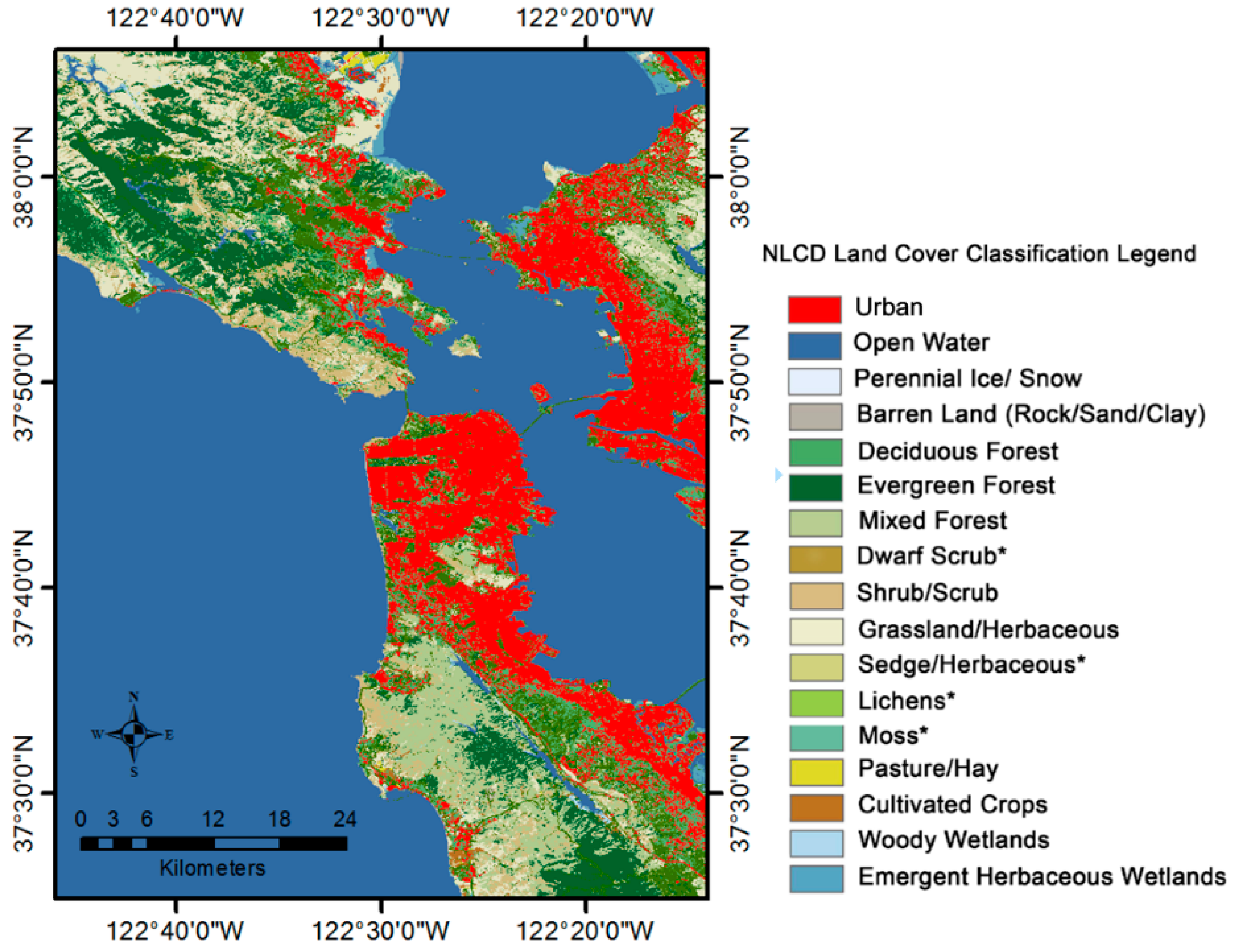
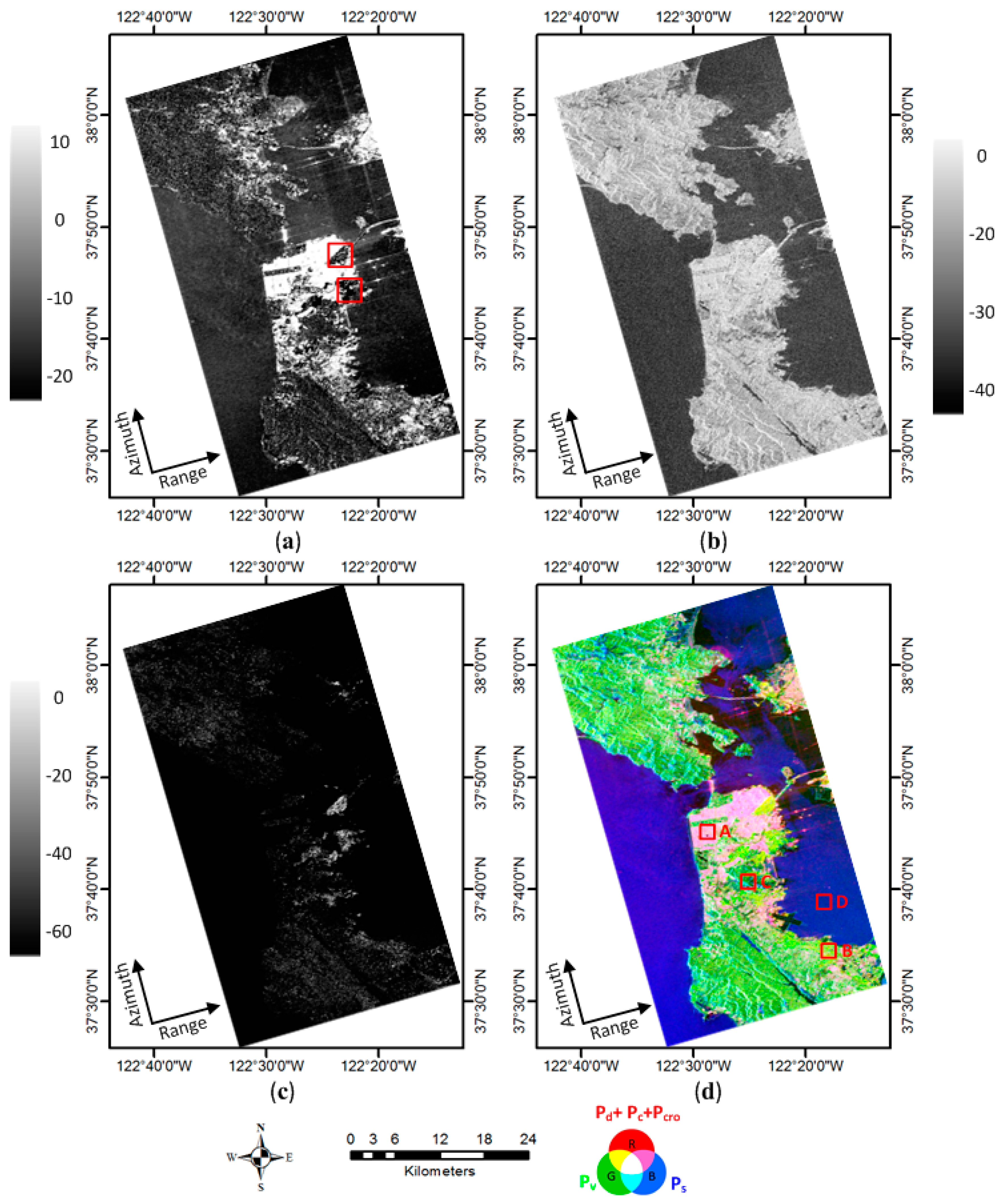
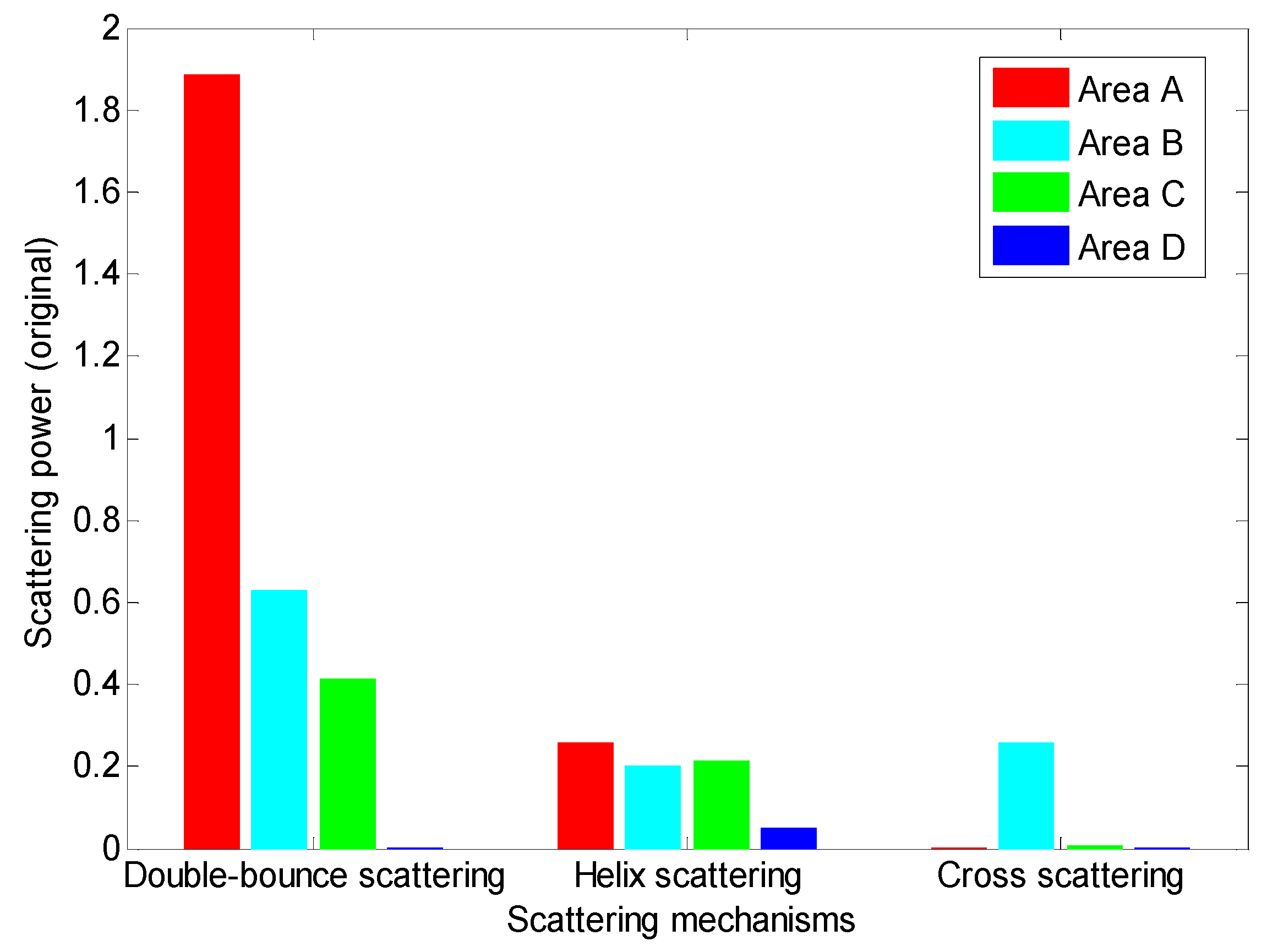
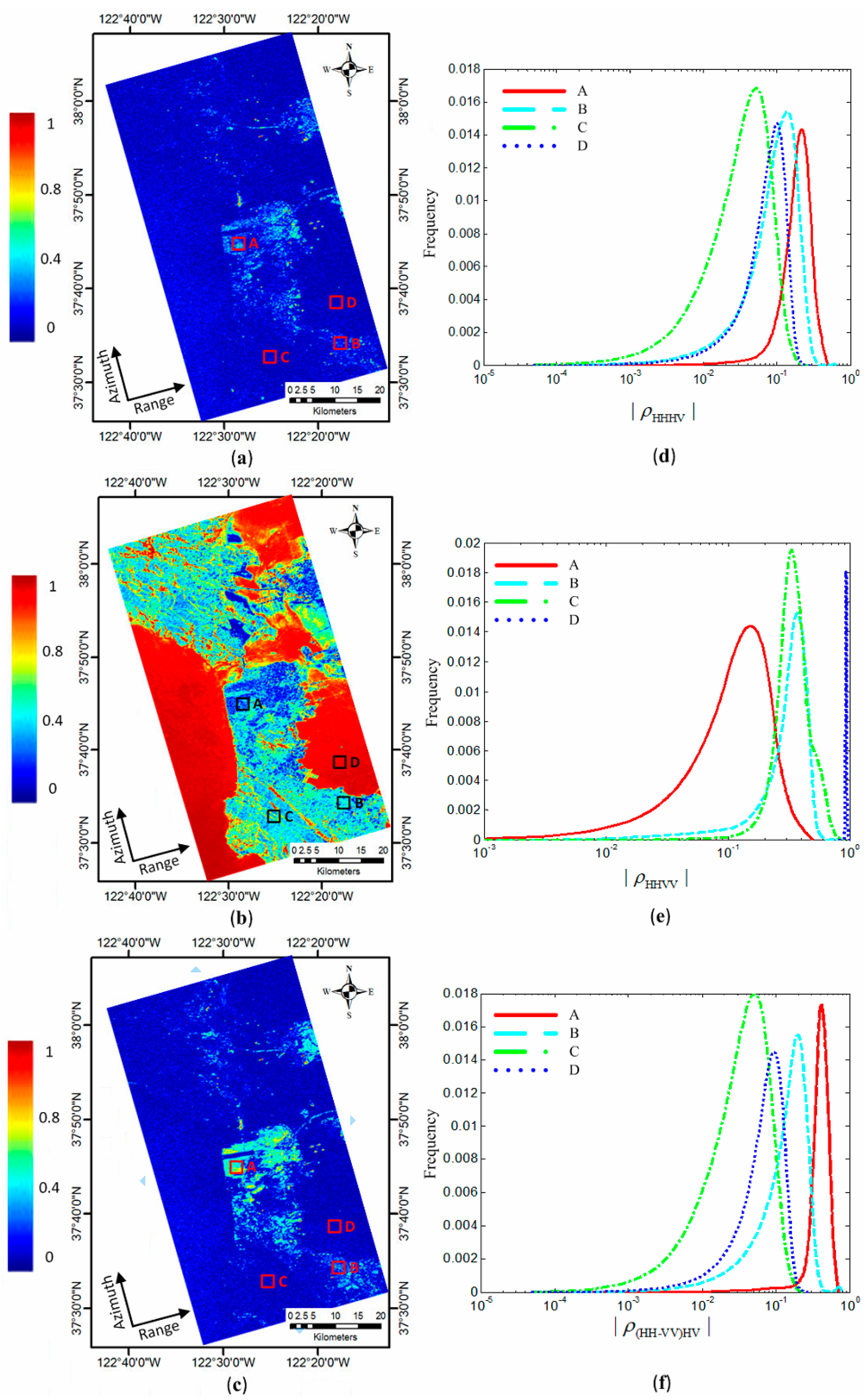
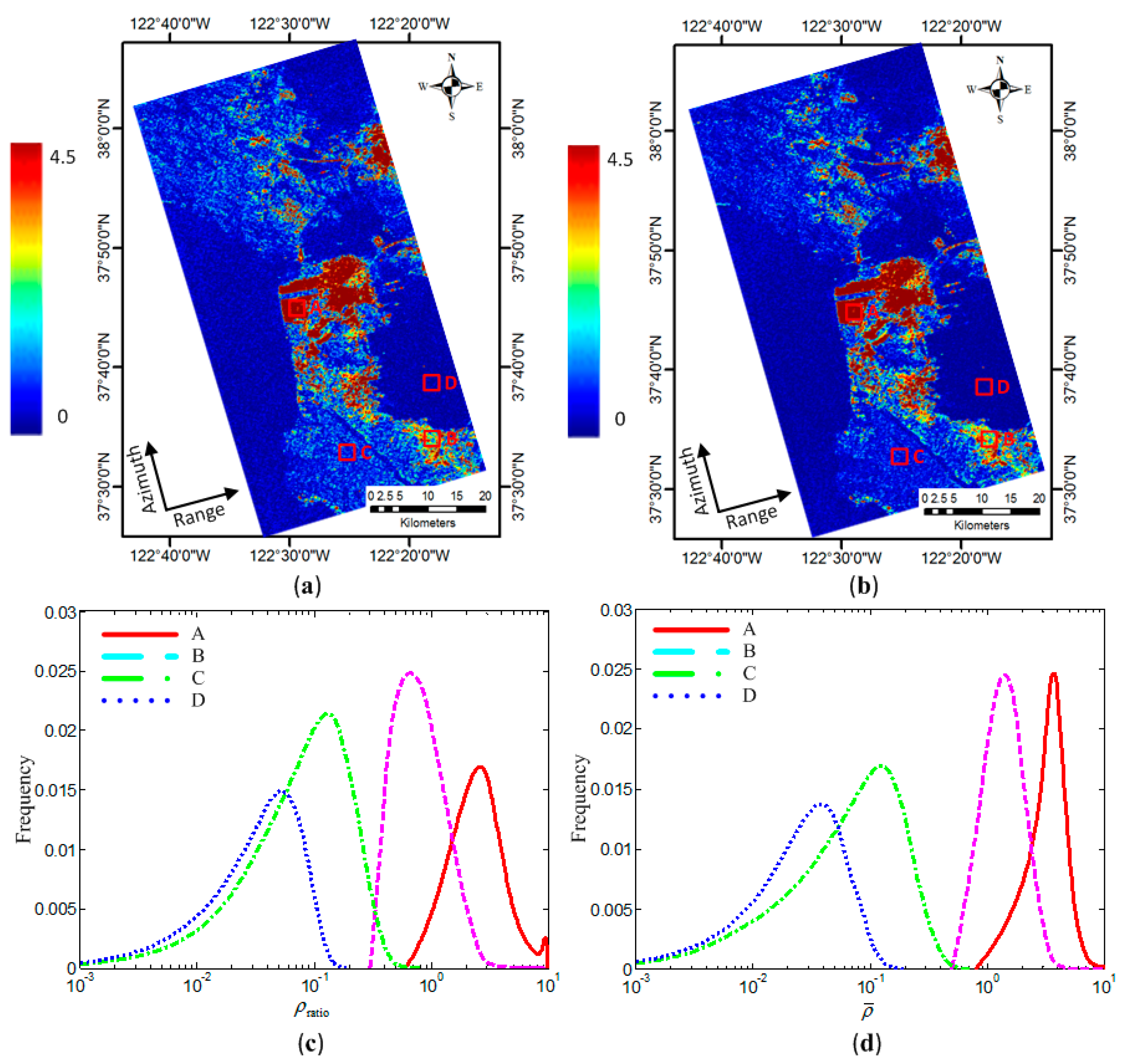
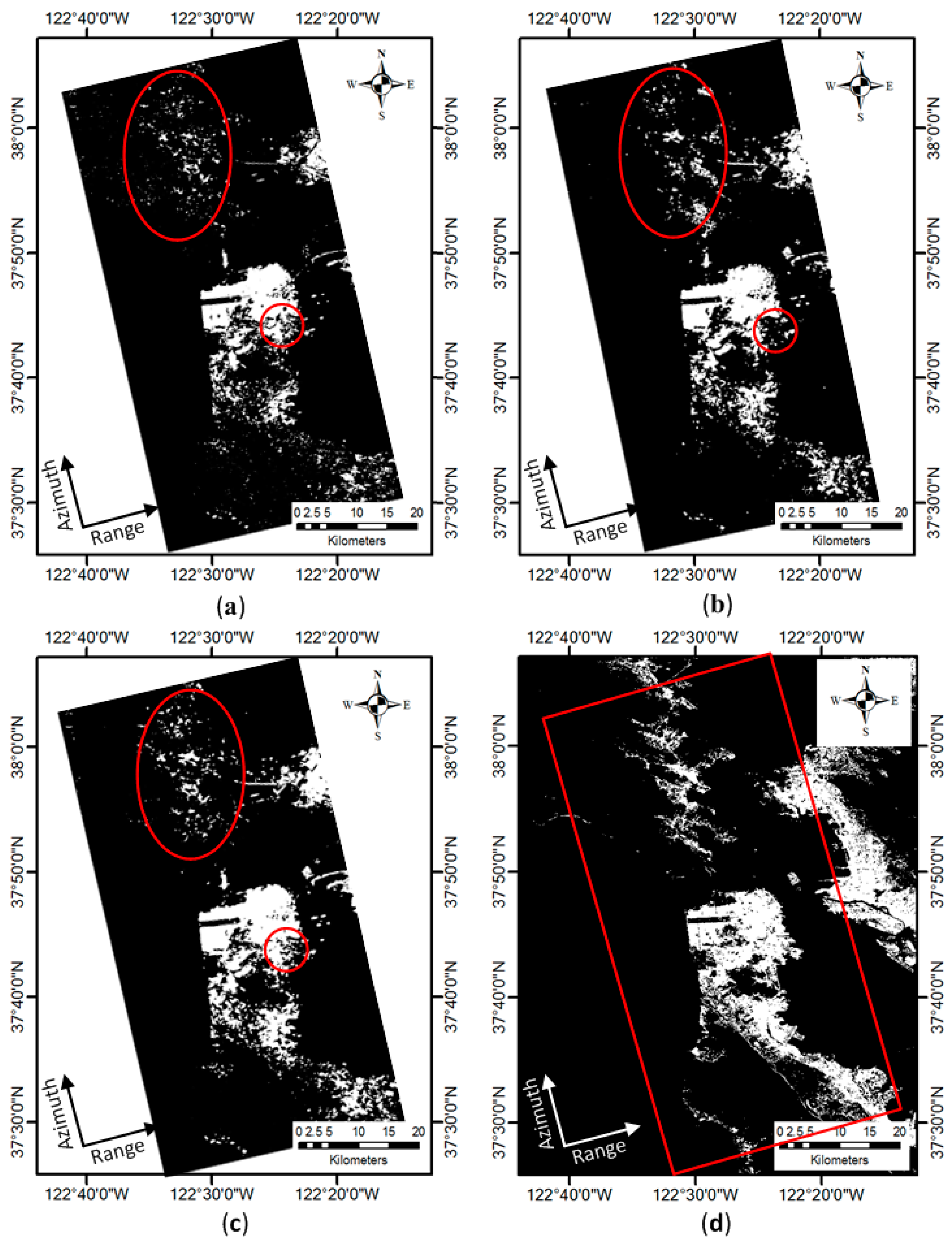

| Date | Flight Direction | Incidence Angle | Band | Looks Number | Data Type |
|---|---|---|---|---|---|
| 11 November 2009 | Ascending | 22° | L | Azimuth: 1 | Complex |
| Range: 1 |
| Area | ||
|---|---|---|
| A | 3.7284 | 3.9541 |
| B | 1.3572 | 2.1536 |
| C | 0.5425 | 0.3287 |
| D | 0.1152 | 0.0852 |
| Method | OA (%) | KC | UA (%) | PA (%) |
|---|---|---|---|---|
| Scattering powers | 83.12 | 0.6624 | 83.21 | 83.15 |
| Average coherence coefficient ratio | 80.13 | 0.6025 | 80.24 | 80.63 |
| FCP fusion | 86.91 | 0.7381 | 87.34 | 86.60 |
© 2016 by the authors; licensee MDPI, Basel, Switzerland. This article is an open access article distributed under the terms and conditions of the Creative Commons Attribution (CC-BY) license (http://creativecommons.org/licenses/by/4.0/).
Share and Cite
Xiang, D.; Tang, T.; Hu, C.; Fan, Q.; Su, Y. Built-up Area Extraction from PolSAR Imagery with Model-Based Decomposition and Polarimetric Coherence. Remote Sens. 2016, 8, 685. https://doi.org/10.3390/rs8080685
Xiang D, Tang T, Hu C, Fan Q, Su Y. Built-up Area Extraction from PolSAR Imagery with Model-Based Decomposition and Polarimetric Coherence. Remote Sensing. 2016; 8(8):685. https://doi.org/10.3390/rs8080685
Chicago/Turabian StyleXiang, Deliang, Tao Tang, Canbin Hu, Qinghui Fan, and Yi Su. 2016. "Built-up Area Extraction from PolSAR Imagery with Model-Based Decomposition and Polarimetric Coherence" Remote Sensing 8, no. 8: 685. https://doi.org/10.3390/rs8080685





